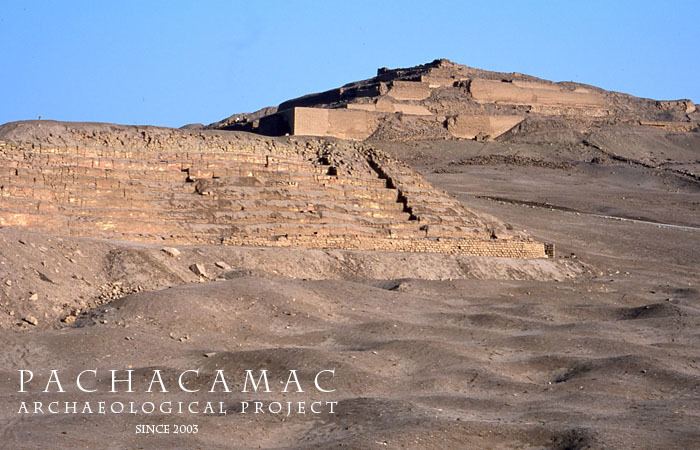 | ||
Periods Middle Horizon, Late Intermediate, Late Horizon Weather 24°C, Wind S at 10 km/h, 87% Humidity | ||
Pachacamac (Quechua: Pachakamaq) is an archaeological site 40 kilometres (25 mi) southeast of Lima, Peru in the Valley of the Lurín River. The site was first settled around A.D. 200 and was named after the "Earth Maker" creator god Pacha Kamaq. The site flourished for about 1,300 years until the Spanish invaded. Pachacamac covers about 600 hectares of land.
Contents
- Pachacamac beto mendez
- Pacha Kamaq God
- Pyramids of Pachacamac
- Temple of the Sun
- Other Structures
- Grave Sites
- Outside influences
- Spanish Invasion
- In popular culture
- References

Pachacamac beto mendez
Pacha Kamaq God
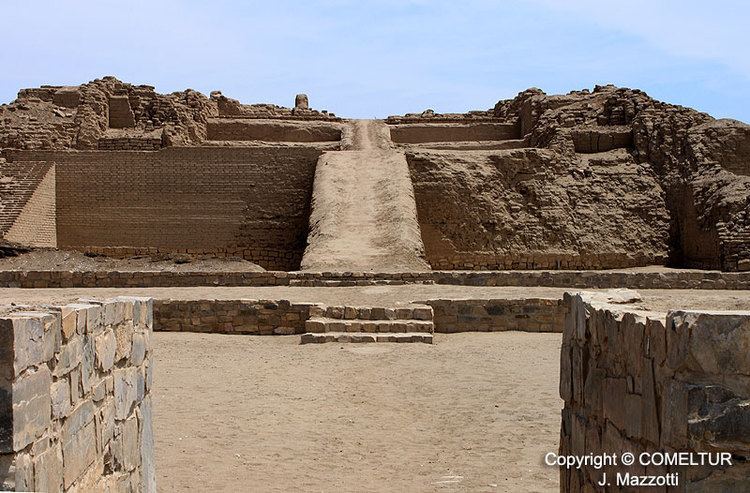
Pacha Kamaq ('Earth-Maker') was considered the creator god by the people who lived in this part of Peru before the Inca conquest. The Inca took him into their pantheon, but was not an equal of Viracocha; Virachocha was seen as being more powerful.
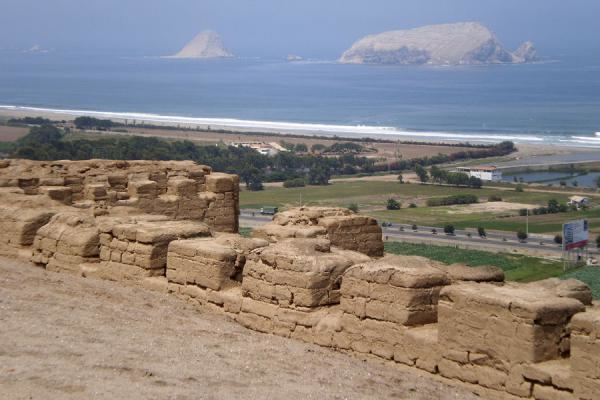
The myths that survive of Pacha Kamaq are sparse and confused: some accounts, for example, identify him as Manco Cápac's cowardly brother Ayca, while others say that he, Manco Cápac and Viracocha were the sole three sons of Inti, the sun god. Another story says that he made the first man and the first woman, but forgot to give them food – and when the man died and the woman prayed over Pachacamac's head to his father Inti to make her the mother of all the peoples of earth, Pachacamac was furious. One by one, as the children were born, he tried to kill them – only to be beaten and to be thrown into the sea by her hero-son Wichama, after which he gave up the struggle and contented himself by becoming the supreme god of fish.
Pyramids of Pachacamac
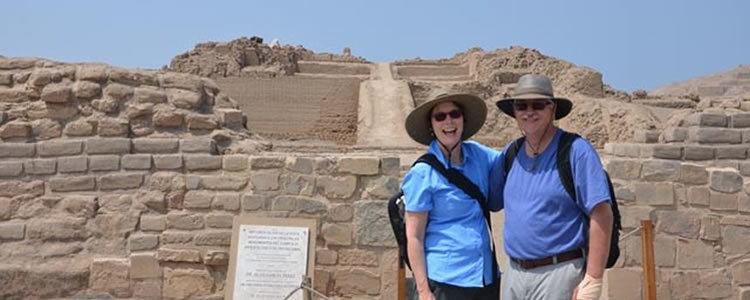
In the 1890s archaeologists first began exploring Pachacamac. They found many enormous buildings and burials that had been previously looted. The first (sacred) section of the site includes temples of religious significance and a large cemetery. The second section includes several buildings which are mainly secular pyramids. In this complex of buildings were mud-brick stepped pyramids with ramps and plazas. These buildings were dated between the late 1300s and the mid-1400s.
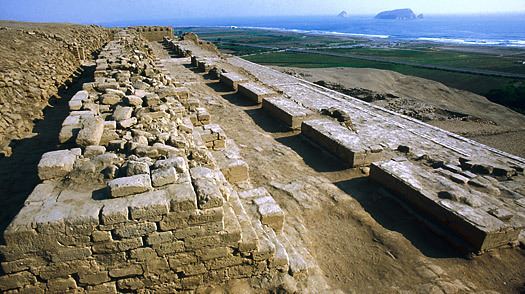
The three most famous pyramids are all found in the first sacred section. These are the Painted Temple, the Temple of the Sun, and the Old Temple of Pachacamac.
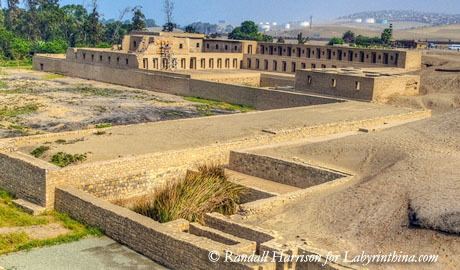
Peter Eekhout is an archaeologist who studied and excavated the site of Pachacamac. According to Eekhout, "For decades most scholars thought the pyramids (from the second section) were religious "embassies" that housed delegations from far-off communities who came to worship, bring tribute, and make offerings to Pachacamac". However, Eekhout came to a different conclusion after his work at the site. Eekhout and his team found that the structures lacked the features that characterized religious centers of the time. He concluded that the structures were used as palaces for the Ychsma (EESH-ma) lords who ruled Pachacamac.
Temple of the Sun

The Temple of the Sun (seen below) is 30,000m squared in size and is in the shape of a trapezoid. It has the common step pyramid architecture which forms terraces around the structure. This temple has been dated to the time of Inca control over Pachacamac. Even though there is no concrete proof, some archaeologists believe human sacrifices may have taken place at this the Temple. Sacrifices of women and children were found in an Inca cemetery within a portion of the structure. Burial goods found with the sacrifices point to the sacrifices originating from coastal societies. Unfortunately archaeologists are limited in their knowledge of this site because the Temple of the Sun and many other pyramids at Pachacamac have been irreversibly damaged by looting and the El Niño weather phenomenon.
Other Structures

Most of the common buildings and temples were built c. 800-1450 CE, shortly before the arrival and conquest by the Inca Empire.
Grave Sites
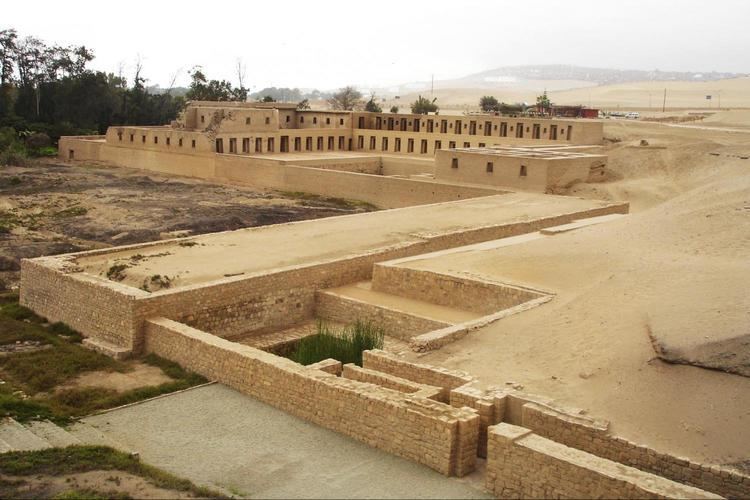
Archaeologists had uncovered multiple grave sites. Each site may date back to different time periods of Pachacamac's history, and these grave sites are located in different parts of the city. In the Southeastern part of the city in the Temple of Inti (The Inca Sun God), archeologists had found a cemetery that was set apart for the mamacuna (Virgins for the Sun), women who had important status. These women wove textiles for priests, and brewed corn beer which was used in Inca festivals. The women were sacrificed in the highest ritual; they had been strangled with cotton garrote, and some women still had the cotton twisted around their neck. They were wrapped in fine cloth and they were buried in stone tombs and each have been surround by offering found in the highlands of Peru area such as coca, quinoa, and cayenne peppers. In 2012, Belgian archeologists found a 1000 year old tomb in front of the Pachacamac containing over 80 skeletons and mummies, many of which were infants. The tomb contained offerings such as ceramic vessels, copper and gold alloy objects, wooden masks, and dogs and guinea pigs.
Outside influences
The Huari (c. 600-800 CE) reconstructed the city, probably using it as an administrative center. A number of Huari-influenced designs appear on the structures and on the ceramics and textiles found in the cemeteries of this period. After the collapse of the Huari empire, Pachacamac continued to grow as a religious center. The majority of the common architecture and temples were built during this stage (c. 800-1450 CE).
The Inca Empire invaded Pachacamac and took over the site around 1470. For the Inca, Pachacamac was extremely important to religion as well as an important administration center. When the Inca started their conquest, they had their own creation god, Viracocha. However, out of respect for the religion of their conquered people, the Inca entered Pacha Kamaq into their religion, but Pacha Kamaq and Viracocha were not equals, Viracocha was believed to be more powerful. Still, Pachacamac was allowed an unusual amount of independence from the Inca Empire
By the time the Tawantinsuyu (Inca Empire) invaded the area, the valleys of the Rímac and Lurín had a small state which the people called Ichma. They used Pachacamac primarily as a religious site for the veneration of the Pacha Kamaq, the creator god. The Ichma joined the Incan Empire along with Pachacamac. The Inca maintained it as a religious shrine and allowed the Pachacamac priests to continue functioning independently of the Inca priesthood. This included the oracle, whom the Inca presumably consulted. The Inca built five additional buildings, including a temple to the sun on the main square.
Archaeologist believe pilgrims may have played a part in life at Pachacamac for a couple thousand years before the Inca claimed the site as part of their empire.
Spanish Invasion
At sites like Pachacamac, the Spanish used local resentment of the Inca as a tactic for overthrowing Inca rule.
After the Battle of Cajamarca, Francisco Pizarro sent his brother Hernando Pizarro, and fourteen horsemen, to Pachacamac to collect its gold riches. According to Cieza, the priests learned of the Spanish defilement of the Cuzco temple, and "ordered the virgin mamaconas to leave the Temple of the Sun from where - as well as from the Temple of Pachacamac - they say they removed more than four hundred cargas of gold. They hid it in secret places, and it has not appeared to this day, nor will it appear, except by chance, because all those who knew about it and hid it, as well as those ordered it, are dead." Hernando departed Cajamarca on 5 Jan. 1533, and returned on 14 April 1533, after defiling the temple. On the return trip through the Jauja Valley, Hernando received the surrender of Chalcuchimac.
"In a few years the walls of the temple were pulled down by the Spanish settlers, who found there a convenient quarry for their own edifices."
